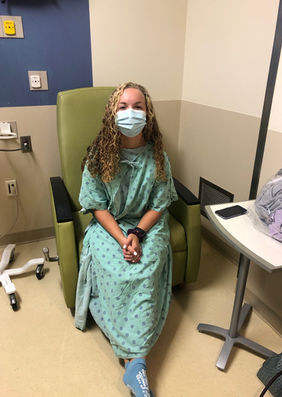CLEFT TIMELINE

Prenatal
Diagnosis of a cleft lip and/or cleft palate in a routine anatomy ultrasound.
Referred to Maternal Fetal Medicine and put in contact with a cleft team.
Genetic counseling is offered.
Education at this time should cover the many different types of clefts and potential causes.
Caregivers should be educated on the ongoing care of children with a cleft need.
Birth-6 months
Newborn hearing screening is done at birth. Referral to an ENT/Auditory specialist if needed.
Consultation with the cleft team shortly after birth.
Caregivers should be aware of the pre-surgical options available or what their
surgeon prefers such as: Taping, NAM, a Latham device, Nasal Elevator, or
obturator.
Cleft Lip Repair
-
Can be accomplished in one surgery, sometimes takes two.
-
Occurs after the baby has demonstrated steady weight gain and is healthy enough to go under anesthesia.
-
Babies will stay overnight for observation.
-
Your surgeon will give you aftercare instructions, which may include the following:
-
Temporarily using syringes before going back to breastfeeding (if palate isn’t affected) or bottle feeding.
-
Using arm immobilizers (no-no’s) to keep baby’s hands away from their mouth and faces.
-
Taking care of the surgical site.
-
Scheduling a post op check up.
-
Early intervention services start at birth and go to age 3 years old.
6 months-2 Years
Palate Repair
-
Done between 6 and 18 months of age, preferring to wait until the child is closer to a year old if possible. It is done prior to much speech development. Timing can always vary due to additional factors and it’s important to keep in contact with your child’s care team.
-
Requires one night observation in the hospital, but some children have issues eating and drinking which may result in a longer stay.
-
There are a variety of aftercare instructions that come with palate repair, so caregivers need to be aware of what their surgeon recommends ahead of time.
-
Some surgeons allow children to go back to bottles after repair, whereas others don’t. Parents are encouraged to assist their children in learning how to use a flat spout sippy cup with the valve removed, an open cup, or a tendercare feeder. See helpful links for cup recommendations.
-
Diet restrictions should be implemented for a short period and may include liquified or pureed foods to start, then when cleared, moving on to soft foods.
-
Arm immobilizers (no-no’s) are frequently used after palate repair.
-
Nothing should go into the child’s mouth like toys, hands, toothbrushes, supply cup spouts, and spoons. Soft coated baby spoons are recommended and should be lined up parallel to the lip to drop food in.
-
Caregivers should also exercise caution when administering medications via syringe.
-
Early intervention services, especially speech can be extremely beneficial to help children navigate the new sounds they can produce since their palate has been closed.
3-5 Years
Children age out of early intervention services at 3 years old. At this time, their care team helps transition them into what services would continue to benefit them.
They are assessed to see if they need to go to developmental preschool or if traditional preschool would work for them.
If speech services are required, parents have the option of utilizing the speech therapist in their school district or seeking private treatment.
At this stage of treatment, an assessment will be done by the speech pathologist on your cleft team.
Velopharyngeal Insufficiency (VPI)
-
See glossary for definition
-
Extremely common and these are detected through a test called a nasoendoscopy.
-
An endoscope is a thin flexible telescope which passes through the nose to the small space behind the nose then past the back of the mouth to the voice box.
-
A local anesthetic is used to perform the test and to get a good speech sample, the child must stay engaged without crying. Thankfully the test is done relatively quickly.
-
If a VPI is discovered, your child’s cleft team will provide you with what your options are. Some surgical options include a furlow z plasty or pharyngeal flap and non-surgical include a speech prosthesis.
Some children have their lip scars revised at this time.
6-12 Years
Orthodontic Assessment and Treatment
Timing can vary, but x-rays need to be done to observe the alignment of teeth and determine if the child will need an alveolar bone graft (see glossary).
Prepwork to the teeth is a necessity before this surgery to reposition upper teeth. Your child will most likely get stage one braces and may have a palate expander placed. A palate expander’s purpose is to slowly expand the roof of the mouth to widen the upper jaw.
In cleft affected children, it is not uncommon for teeth to be crowded, crooked, overlapping, or to have extra teeth. A crossbite is also very common, which means some upper teeth sit inside the lower teeth.
Once the orthodontist expands the upper jaw, the bone graft surgery is done. When there is a gap in the alveolar ridge (see glossary), the necessary bone for adult teeth to come through is missing in the cleft site. During this surgery, an oral surgeon will harvest cancellous bone or spongy bone from the illiac crest, which is the upper ridge of the hip bone. Because it is soft and pliable, it is placed to close the gap between the teeth in the alveolar ridge and will turn into hard bone.
15-20 Years
Additional orthodontic work may be necessary around 15 years of age to prepare for orthognathic surgery.
Orthognathic surgery involves re-aligning the jaws to change the appearance of a person’s profile. This surgery is done after the individual's facial growth has completed (typically around 15-16 years old in females and 18-19 years old in males).
If revisions are necessary or desired by the individual, they should be revised after facial growth is complete in order to improve airflow as well as symmetry of facial features. Different types of surgeries may be requested for different reasons.
Some examples of surgeries include:
Rhinoplasty (surgery to change the shape of the nose)
Dental surgery (possible implants)
Lip revision
Palatal fistula closure (closing small holes in the palate)
Management of speech and hearing issues is ongoing.
21+
Coming Soon....
Credit Disclaimer - Portions of this timeline were derived from the following resources: CLAPA, SMILE TRAIN, AND THE ACPCA











































